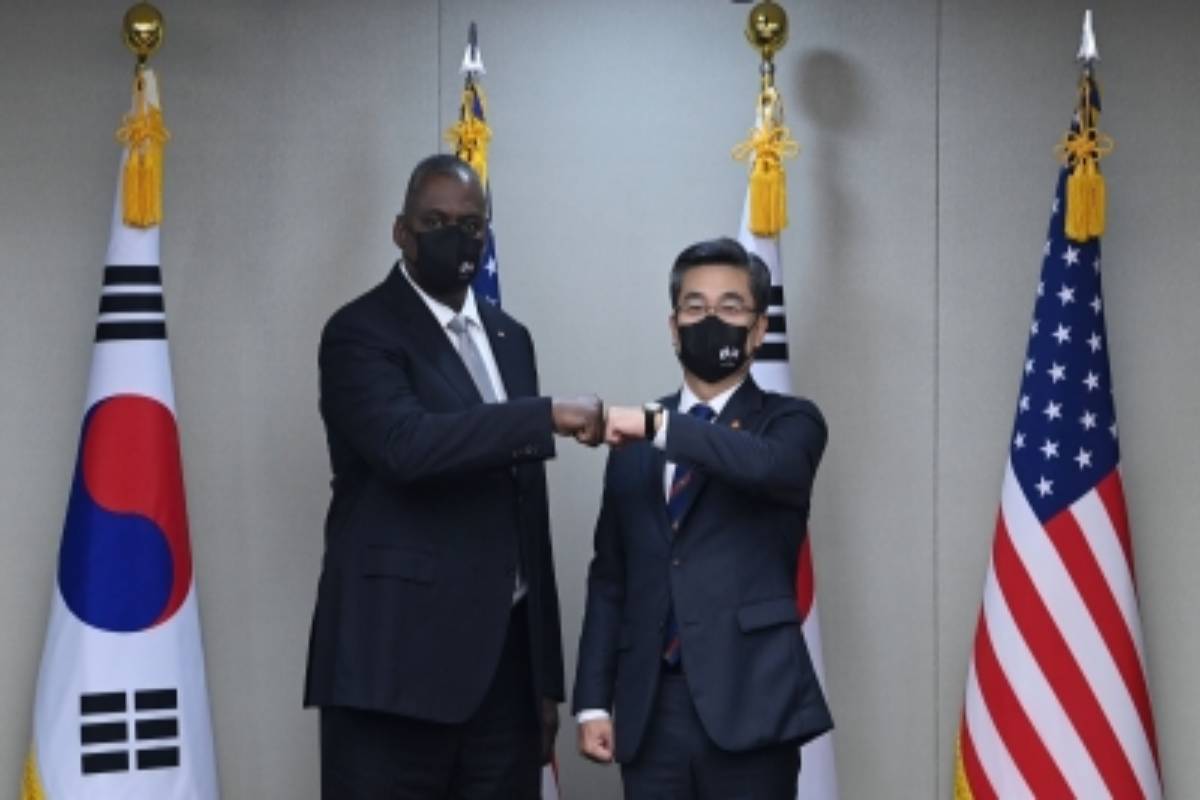Hyundai, Kia’s Europe sales down 7.5 pc in October
Combined vehicle sales of Hyundai Motor and Kia, South Korea's leading automakers, in Europe fell 7.5 per cent in October from a year ago, industry data showed on Thursday.
South Korea retook peacetime OPCON in 1994, but the US still possesses wartime OPCON. The wartime OPCON transfer was previously set for 2015 but was postponed.

Image credit: IANS
South Korea and the US agreed on Thursday to update their joint wartime contingency plans to deter North Korea’s evolving nuclear and missile threats, the two sides said, in a sign of their stepped-up cooperation to reinforce deterrence against the recalcitrant regime.
Defence Minister Suh Wook and his US counterpart, Lloyd Austin, approved the “Strategic Planning Guidance (SPG),” a document to set the tone for updated wartime operation plans (OPLANs), during the allies’ annual Security Consultative Meeting (SCM).
Calls have persisted for rewriting the decade-old strategic guidance that critics said has become outdated following major advancements in the North’s weapons development programmes, including its refined nuclear arms, submarine-launched ballistic missiles and a hypersonic missile, Yonhap news agency reported.
Advertisement
During a joint press conference with Suh, Austin took a swipe at the North’s “destabilising” weapons programmes.
“We also reaffirmed our shared assessment that the DPRK is continuing to advance its missile and weapons programmes, which is increasingly destabilising for regional security,” Austin said, referring to the North’s official name, Democratic People’s Republic of Korea.’
But he highlighted the allies’ commitment to a “diplomatic approach” to the North.
Suh said the new SPG came as the allies shared the need to reflect on their updated war plans, the changes in North Korean threats, South Korea’s defence reform efforts and the overall “shifting strategic environment.”
The strategic guidance is designed to provide the allies’ Military Committee, led by their Joint Chiefs of Staff chairmen, with authorization for a war plan, which is to be written by the South Korea-US Combined Forces Command (CFC).
The joint SCM communique said that the latest guidance “will guide military OPLANs to more effectively deter — and as necessary respond to — DPRK threats to the US-ROK Alliance.” ROK stands for South Korea’s official name, the Republic of Korea.
The new guidance marks a manifestation of the allies’ resolve to harness their combined military capabilities to respond to various wartime scenarios, including the North’s use of both nuclear and conventional strikes, observers said.
The guidance is likely to pave the way for a major change to the current OPLAN 5015 that lays out a series of procedures to handle an all-out war with the North. OPLAN 5015 is known to focus largely on handling conventional attacks — a reason why calls for its replacement or an update have surfaced.
Apparently mindful of security concerns here, Austin reiterated the “firm” US commitment to providing extended deterrence to South Korea “utilising the full range of US defence capabilities, including nuclear, conventional, and missile defence capabilities,” according to the communique.
Also at the SCM, Suh and Austin pledged to conduct the full operational capability (FOC) assessment for the conditions-based transfer of wartime operational control (OPCON) in the fall of 2022 after a period of pandemic-driven delay.
The FOC assessment is the second part of a three-phase programme to verify if South Korea is ready to lead the allies’ combined forces during wartime.
“The minister and I also agreed to conduct an FOC assessment of our future Combined Forces Command during next fall’s combined command post training,” Austin said.
“This represents an important task toward meeting the conditions necessary for OPCON transition,” he added.
Even if the FOC verification is over, the allies face the full mission capability assessment, the third and last part of the verification programme, meaning it is virtually impossible for Seoul to retake wartime OPCON before the end of the Moon Jae-in administration in May next year.
South Korea handed over operational control over its troops to the US-led UN Command during the 1950-53 Korean War. It was then transferred to the US-led CFC when the command was launched in 1978.
South Korea retook peacetime OPCON in 1994, but the US still possesses wartime OPCON. The wartime OPCON transfer was previously set for 2015 but was postponed, as the allies agreed in 2014 to a conditions-based handover due to Pyongyang’s rising nuclear and missile threats.
In the SCM joint statement, the minister and secretary acknowledged the importance of preserving peace and security in the Taiwan Strait — the first mention of the sensitive issue in the SCM, which analysts said signalled the expanding scope of the bilateral alliance to cover security far beyond the Korean Peninsula.
The Taiwan Strait was also mentioned in the joint statement issued at the close of the summit between Presidents Moon and Joe Biden in May. But its mention in the allies’ security document hinted at Washington’s effort to rally allies against an assertive China.
“The two leaders reaffirmed the importance of the rules-based international order and adherence to international rules and norms, including those of freedom of navigation and overflight,” the communique reads with no mention of China.
The SCM statement also emphasized the US’ commitment to maintaining the current level of 28,500 American troops in South Korea. Last year’s version did not mention it amid tensions over the prolonged cost-sharing negotiations for the upkeep of the US Forces Korea.
In the statement, the two defence chiefs also pledged to closely cooperate on the relocation of the allies’ Combined Forces Command headquarters to Camp Humphreys in Pyeongtaek, 70 kms south of Seoul, by next year.
They also reaffirmed the plan for the return of parts of the US military’s Yongsan Garrison in the capital by early next year, a move likely to back a mega project to build a national park there.
They also agreed to work together to promote closer cooperation in strategically crucial security domains of cyberspace and space.
Advertisement